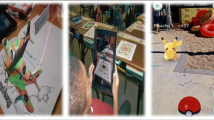Abstract
This work examines the forensic aspects of using augmented reality (AR) technology. It is proposed to use reality technology to reconstruct the picture of crimes committed in transport. A feature of the reconstruction of the trace picture of crimes of this type is visualizing the connections between objects that are not comparable in size to trace-perceiving objects. It is concluded that augmented reality technology can become the basis for a new stage in the development of forensic photography. AR technology provides simultaneous image of traces of crime on objects, then it becomes possible to combine in one computer application the advantages of orientation, survey, nodal and detailed photography. The technology based on markers (AR-tags) requires a minimum of equipment. For a smartphone, the article's authors have developed an application that allows visualizing a forensic scene using augmented reality. The experience of using a computer AR-application in forensic practice and training in reconstruction of the track picture of crimes in transport is analyzed. With the help of virtual objects, the trail picture of the murder in the ship's cabin was reconstructed. During reconstruction, augmented reality marks are digital pointers, which, during real investigative examinations of the scene of the incident, indicate the traces of the crime. The advantages of using an application for a smartphone in the educational process carried out in the conditions of an educational forensic training ground (AR-training ground) are considered.
Access this chapter
Tax calculation will be finalised at checkout
Purchases are for personal use only
Similar content being viewed by others
References
Ma, M., Zheng, H., Lallie, H.: Virtual reality and 3 D animation in forensic visualization. J. Forensic Sci. 55(5), 12271231 (2010)
Zhang, L., Ding, Z., Li, H., et al.: Dear identification based on sparse representation. PLoS ONE 9(4), 1–9 (2014)
Streefkerk, J.W., Houben, M., van Amerongen, P., ter Haar, F., Dijk, J.: The ART of CSI: an augmented reality tool (ART) to annotate crime scenes in forensic investigation. In: Shumaker, R. (ed.) VAMR 2013. LNCS, vol. 8022, pp. 330–339. Springer, Heidelberg (2013). https://doi.org/10.1007/978-3-642-39420-1_35
Datcu, D., Lukosch, S., Lukosch, H., Cidota, M.: Using augmented reality for supporting information exchange in teams from the security domain. Secur. Inform. 4(1), 1–17 (2015). https://doi.org/10.1186/s13388-015-0025-9
Poelman, R., Akman, O., Lukosch, S., et al.: As if being there: mediated reality for crime scene investigation. In: CSCW 2012: Proceedings of the ACM 2012 Conference on Computer Supported Cooperative Work. Association for Computing Machinery, New York, pp. 1267–1276 (2012). https://doi.org/10.1145/2145204.2145394
Lukosch, S.G., Poelman, R., Akman, O., et al.: A novel gesture-based interface for crime scene investigation in mediated reality. In: Proceedings of the CSCW Workshop on Exploring Collaboration in Challenging Environments, Seattle, Washington, pp. 1–4. ACM (2012)
Kobayashi, L., Zhang, X.C., Collins, S.A., et al.: Exploratory application of augmented reality/mixed reality devices for acute care procedure training. West J. Emerg. Med. 19(1), 158–164 (2018). https://doi.org/10.5811/westjem.2017.10.35026
Miller, M.R., Jun, H., Herrera, F., et al.: Social interaction in augmented reality. PLoS ONE 14(5), e0216290 (2019). https://doi.org/10.1371/journal.pone.0216290
Kuzenkova, G.V., Tolstolutsky, V.U.: Augmented reality as an additional means of forensic training. Mod. Probl. Sci. Educ. 3, 1–13 (2021). https://doi.org/10.17513/spno.30786
Kommera, N., Kaleem, F., Shah Harooni, S.M.: Smart augmented reality glasses in cybersecurity and forensic education. In: 2016 IEEE Conference on Intelligence and Security Informatics (ISI), Tucson, AZ, pp. 279–281. IEEE (2016). https://doi.org/10.1109/ISI.2016.7745489
Anderson, A.: Virtual Reality, Augmented Reality and Artificial Intelligence in Special Education: A Practical Guide to Supporting Students with Learning Differences. Routledge, New York (2019)
Leung, W.S., Blauw, F.F.: An augmented reality approach to delivering a connected digital forensics training experience. In: Kim, K.J., Kim, H.-Y. (eds.) Information Science and Applications. LNEE, vol. 621, pp. 353–361. Springer, Singapore (2020). https://doi.org/10.1007/978-981-15-1465-4_36
Kilgus, T., et al.: Mobile markerless augmented reality and its application in forensic medicine. Int. J. Comput. Assist. Radiol. Surg. 10(5), 573–586 (2014). https://doi.org/10.1007/s11548-014-1106-9
Gee, A.P., Escamilla-Ambrosio, P.J., Webb, M., et al.: Augmented crime scenes: virtual annotation of physical environments for forensic investigation. In: MiFor 2010 Proceedings of the 2nd ACM Workshop on Multimedia in Forensics, Security and Intelligence, New York. Association for Computing Machinery, pp. 105–110 (2010). https://doi.org/10.1145/1877972.1877999
Daeid, N.N., Thomson, G.: Using virtual reality, augmented reality and mixed reality for crime scene visualization (2020). https://www.dundee.ac.uk/projects/using-virtual-reality-augmented-reality-and-mixed-reality-crime-scene-visualization. Accessed 15 May 2021
Shchur, L., Ziganurova, L.: Simulation of virtual time profile in conservative parallel discrete event simulation algorithm for small-world network. Lobachevskii J. Math. 38, 967–970 (2017). https://doi.org/10.1134/S1995080217050316
Author information
Authors and Affiliations
Editor information
Editors and Affiliations
Rights and permissions
Copyright information
© 2022 The Author(s), under exclusive license to Springer Nature Switzerland AG
About this paper
Cite this paper
Tolstolutsky, V., Kuzenkova, G., Malichenko, V. (2022). The Experience of Using Augmented Reality in the Reconstruction of the Crime Scene Committed in Transport. In: Manakov, A., Edigarian, A. (eds) International Scientific Siberian Transport Forum TransSiberia - 2021. TransSiberia 2021. Lecture Notes in Networks and Systems, vol 402. Springer, Cham. https://doi.org/10.1007/978-3-030-96380-4_120
Download citation
DOI: https://doi.org/10.1007/978-3-030-96380-4_120
Published:
Publisher Name: Springer, Cham
Print ISBN: 978-3-030-96379-8
Online ISBN: 978-3-030-96380-4
eBook Packages: EngineeringEngineering (R0)




